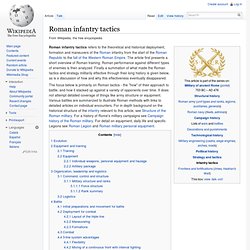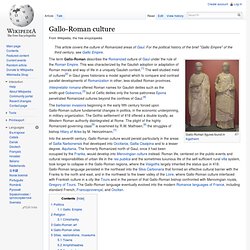

Bread and Circuses. Romans. What have the Romans done for us?
Roman infantry tactics, strategy and battle formations. Roman infantry tactics refers to the theoretical and historical deployment, formation and maneuvers of the Roman infantry from the start of the Roman Republic to the fall of the Western Roman Empire.

The article first presents a short overview of Roman training. Roman performance against different types of enemies is then analyzed. Finally a summation of what made the Roman tactics and strategy militarily effective through their long history is given below, as is a discussion of how and why this effectiveness eventually disappeared. The focus below is primarily on Roman tactics - the "how" of their approach to battle, and how it stacked up against a variety of opponents over time.
It does not attempt detailed coverage of things like army structure or equipment. Evolution[edit] Roman military tactics and strategy evolved from that typical of a small tribal host seeking local hegemony, to massive operations encompassing a world empire. Equipment and training[edit] A turf and timber Roman fort near Coventry. [Ancient] Rome. Gallo Roman. This article covers the culture of Romanized areas of Gaul.

For the political history of the brief "Gallic Empire" of the third century, see Gallic Empire. Interpretatio romana offered Roman names for Gaulish deities such as the smith-god Gobannus,[3] but of Celtic deities only the horse-patroness Epona penetrated Romanized cultures beyond the confines of Gaul.[4] The barbarian invasions beginning in the early fifth century forced upon Gallo-Roman culture fundamental changes in politics, in the economic underpinning, in military organization. The Gothic settlement of 418 offered a double loyalty, as Western Roman authority disintegrated at Rome. The plight of the highly Romanized governing class[5] is examined by R.W. Into the seventh century, Gallo-Roman culture would persist particularly in the areas of Gallia Narbonensis that developed into Occitania, Gallia Cisalpina and to a lesser degree, Aquitania.
Politics[edit] Gallic Empire[edit] Religion[edit] Christianity[edit] Roaming Romans. Roman History. Roman bath. In ancient Rome, Thermae (from Greek θερμός thermos, "hot") and balnea (from Greek βαλανεῖον balaneion) were facilities for bathing.

Thermae usually refers to the large imperial bath complexes, while balneae were smaller-scale facilities, public or private, that existed in great numbers throughout Rome.[1] Terminology[edit] Thermae, balneae, balineae, balneum and balineum may all translated as "bath" or "baths", though Latin sources may distinguish among these terms.
Balneum or balineum, derived from the Greek βαλανεῖον[3] signifies, in its primary sense, a bath or bathing-vessel, such as most persons of any consequence amongst the Romans possessed in their own houses,[4] and hence the chamber which contained the bath,[5] which is also the proper translation of the word balnearium. Building layout[edit] A public bath was built around three principal rooms: the caldarium (hot bath), the tepidarium (warm bath) and the frigidarium (cold bath).